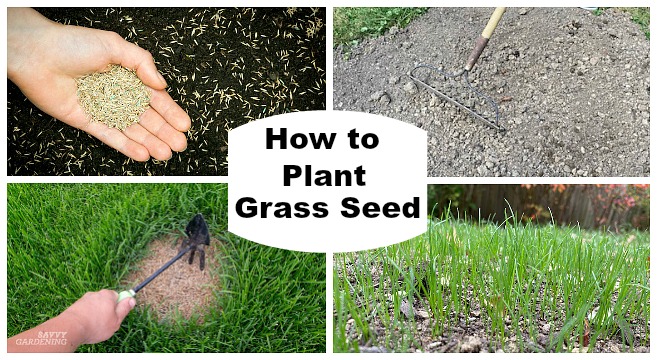Plant grass seed. We know from our own experience that creating a new lawn with grass seeds and maintaining an existing area can be quite a challenge. This is why today, we want to present you with our seven steps on how to sow grass seeds successfully. The steps come from our own experience but are also supplemented by the expertise of the German Lawn Society and the feedback from our customers.
Table of Contents
Step 1: The selection of the grass seeds determines the success: plant grass seed

Plant grass seed. Before sowing the grass seeds, ask yourself what the purpose of the lawn will be and what is the goal you want to achieve. Do you want a particularly hard-wearing surface so that the children and the dog can play outside? Then it would help if you thought about a lawn for use, a hard-wearing lawn, or even a sports lawn. However, if you want your property to look flawless, the ornamental lawn is more interesting for you. If you are commercially interested in greening a golf course or a football stadium, the golf turf and the sports and football turf are the right choices.
When making your selection, make sure that the grass seeds are of high quality. Cheap products are often not subject to any controls and take refuge in freely definable mixtures such as “Berliner Tiergarten.”
Step 2: Create a strong foundation for the grass seeds
Every grass is a lawn plant which, like most other plants, needs four things above all for the grass seeds to develop stable, resilient growth:
- light
- water
- warmth
- nutrient
The so-called location factors have a decisive influence on the success of your lawn’s growth. You should already consider when mixing the grass seeds if your soil in the garden is subject to particular circumstances. Is there a lot of shade on the lawn? Is the soil very porous because it has a high proportion of sand? Does the ground have very few nutrients? You should determine this data through observation and, ideally, through a soil sample.
Grass seeds: completely rebuild the lawn:
Especially with new buildings, the lawn in the garden is the last part to design. In the near past, construction machinery was up to mischief. A beautiful property is now to create. In such a case, attention should pay to the quality of the soil. It highly recommends enriching the ground with mother earth so that fertile soil can develop. In addition, care should be taken to ensure that it is neither too porous (due to sand, for example) nor too impermeable (due to clay and loam, for example). If this is the case, remedial action can be taken with the other element.
Before the first grass seed sow, the area should crumble as finely as possible. A level lawn is to create here later, so it is essential to remove unevenness and make the surface as acceptable as possible.
Grass seeds: the ideal subsoil:
Whether it is a new installation or the renovation of an existing area, your lawn is well prepares with these measures. In front of you is a flat, fine-grained surface that will appear lush green in just a few weeks. The next step is to enrich the soil with nutrients to create the best possible growth conditions for the grass seeds.
Step 3: starter fertilizer to support the grass seeds
Now that you have laid the foundation for the grass seeds, the next step is to prepare the necessary nutrients. It is essential to pay attention to the composition of the fertilizer mixture. Depending on the quality of the soil and any nutrients that may be missing in your soil, comprehensive advice can make sense here. The so-called starter fertilizer recommends in any case for the grass seeds. Too high a nitrogen content leads to excessive growth that requires you to mow every two to three days.
Fertilize the area for the grass seeds 1 to 2 weeks before sowing: plant grass seed
It is an advantage to applying the fertilizer about two weeks before planting the grass seeds. The soil absorbs the fertilizer during this time, and the nutrient depots fill accordingly. The complete nutrient depots are immediately available if the grass seeds come onto the area and develop the first germs.
Of course, it is also possible to apply the seeds together with the fertilizer, but the nutrients are not yet available for the grass seeds in the soil.
Step 4: Evenly sowing the grass seeds promises the most remarkable success.
When sowing, you should also use a spreader or hand spreader again. The use of the devices ensures that the grass seeds evenly distribute over the area. This especially helps with growth. If the grass seeds are spread to collect at specific points, the nutrient density per germ is lower, and the plants also hinder each other when growing in space. Even if the image of the sowing farmer is still in our minds, you should rely on today’s technical aids when sowing to optimize the result.
Grass seeds: roll and compact
After sowing the grass seeds, the area should work with a roller so that the grass seeds press against the ground. It is also possible to spread a few millimeters of soil to cover the grass seeds. This protects against bird damage and the rinsing of the grass seeds in the rain or by watering. For larger areas, a small hand roller recommends, which can usually borrow from the regional hardware store.
Water to start the grass seed germination process.
Like any other grass seed, grass seed also a core enclose in starch and covered by a coat. For the heart to stimulate to grow, it needs the nutrients from the starch layer. This, in turn, needs moisture and water to swell and make the nutrients usable for the germ. That is why it is essential, especially after sowing in the following weeks, that the grass seeds always keep moist. Drying out means that the seedling dies as it sprouts.
Step 5: Regular maintenance prevents all problems
After the first lawn cuts, you will slowly get a feel for your lawn. Especially in the growing season up to summer, it will probably be necessary to mow it down every five to seven days. However, if you perform this task regularly and do not make any exceptions, you will get a very stable and robust lawn. He will thank you for training in difficult times of the year, such as midsummer. Heat, drought, and above all, the stress on the area drains the turf forces.A
Also Read: How to dispose of batteries



















